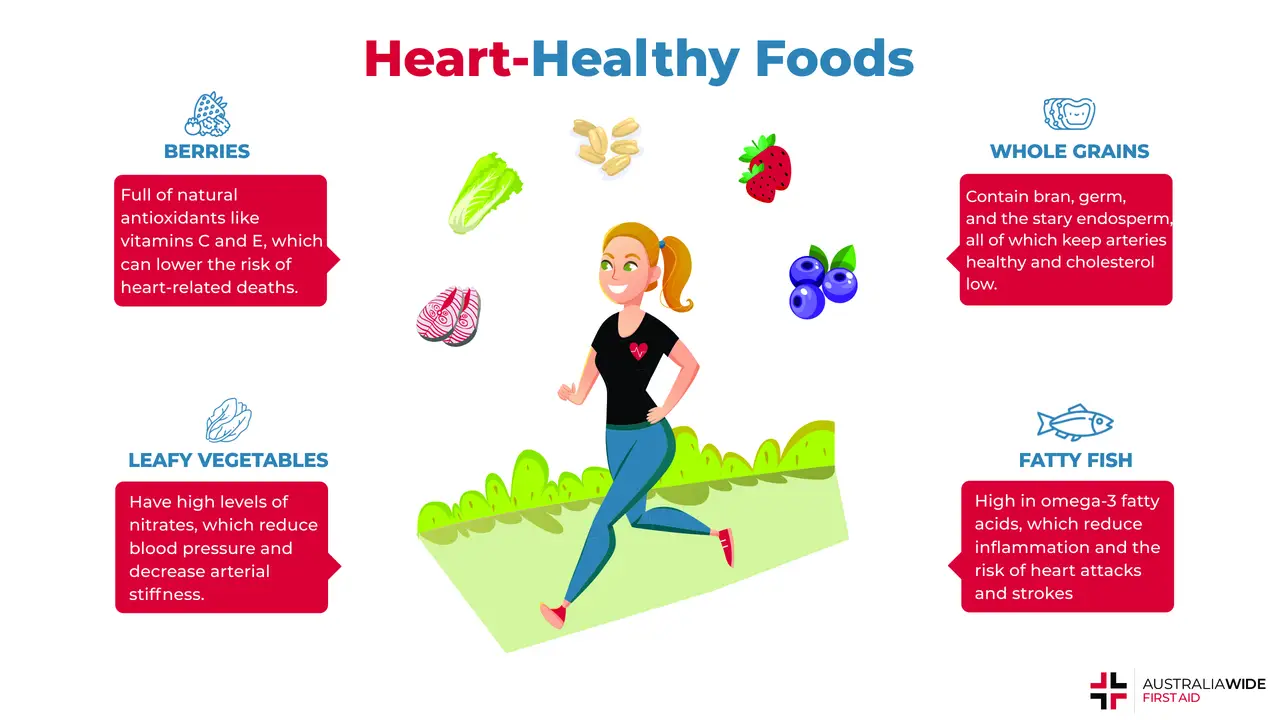Healthy Foods that Protect the Heart


The term “heart disease” refers to several types of heart conditions including heart attacks, heart failure, cardiac arrest, and coronary artery disease.
As the leading cause of death in Australia for both males and females, protecting the heart is vital in ensuring a long and healthy lifespan.
This complex organ can be susceptible to heart diseases either from hereditary heart conditions or as a result from lifestyle choices.
According to the Australian Bureau of Statistics, coronary heart disease was reported to be the leading cause of death in Australia as it accounted for 10.8% of all deaths in 2019.
Despite the heart only being the size of a fist, this organ is responsible for pumping blood throughout the body to send nutrients to our organs. However, like any well-oiled machine, the heart is susceptible to breakages if not maintained and taken care of. This can lead to fatal heart diseases such as heart attack, heart failure, cardiomyopathy, and coronary artery disease.
To provide maximum protection for your heart, here are 5 healthy foods that can help reduce your risk of heart disease.
As tiny as they are, berries are full of nutrients and antioxidants that have shown to significantly reduce the risk factors of heart disease. Berries in general are low in calories and are high in moisture and fibre. They contain natural antioxidants such as vitamins C and E, and nutrients such as folic acid, calcium, and flavonoids, that are associated with a lower risk of heart-related deaths.
According to a study in the Nutrition Review, subjects ranging from healthy humans to subjects with diabetes or smokers have shown a significant decrease in heart disease risk factors. These include a decrease in glucose, fatty acids, and the lowering of blood pressure.
Dietitians recommend consuming 1 cup (148 grams) of berries per day. Ideally, these berries would be consumed whole as these would provide the most benefits compared to juices or extracts, which do not have the same nutritional value. Including all types of berries from fresh to frozen as part of a regular diet has proven to be the best way to consume berries while retaining its health benefits.
Some berries you can consider adding to your diet include:
Incorporating whole grain foods into your daily diet is an excellent way to reduce your risk of heart disease as it helps reduce cholesterol, blood pressure, and manage weight loss. Eating just 25 grams of whole grains a day may reduce your risk of heart disease by 15%, as reported from a study of health professionals at the Harvard School of Public Health in Boston.
But what makes whole grains so significant to the human heart? Whole grains have three parts: bran, germ, and the stary endosperm. Refined grains are stripped of bran and germ – taking away nearly all the fibre and nutrients and leaving behind only calories. With all three parts intact, whole grain foods provide fibre that keep arteries healthy by lowering cholesterol levels and keeping you fuller for longer.
In addition to fibre, whole grains provide nutrients like thiamine (vitamin B1), riboflavin (vitamin B2), niacin (vitamin B3), folate (vitamin B9), iron, and magnesium. These are crucial to bodily functions such as forming new cells, carrying oxygen in the blood, and maintaining a healthy immune system.
Some whole grain foods you can include are:
As part of a well-rounded diet, vegetables are a food group that is vital to our growth and development. A study from Edith Cowan University found that simply eating 80 grams of raw leafy vegetables daily may help with significantly reducing your risk of heart disease due its high concentration of nitrates. This helps in reducing blood pressure, decreasing arterial stiffness, and promoting healthy blood vessels. The higher the nitrate intake, the greater these effects will be.
Leafy vegetables are also an excellent source of vitamin K which help protect your arteries by promoting proper blood clotting. This is crucial to maintaining a healthy heart as blood clots are the main culprit of heart attack symptoms such as crushing chest pains, sweating, shortness of breath, and pain down the left arm.
Examples of leafy vegetables you can include in your diet are:
Fatty fish are high in omega-3 fatty acids – a type of unsaturated fatty acid that helps in reducing inflammation throughout the body. Inflammation in the body can be dangerous as it can damage blood vessels, leading to heart attacks and strokes.
It is recommended by the Heart Foundation that 2 – 3 servings of fish per week may help reduce a type of fat called triglycerides that are carried in our blood and stored as fat cells. High levels of triglycerides contribute to the hardening of arteries and thickening of artery walls – which may increase the risk of stroke and heart attack.
Omega-3 fatty acid is also a natural anticoagulant, which means it can prevent the blood from clotting too much. By preventing blood from clotting, it is less likely to block blood flow in the arteries. This allows oxygen and nutrients to travel uninterrupted throughout the body and improve blood circulation.
Some common fatty fish you can include are:
Eating tofu and other plant-based proteins have shown to be effective in reducing the risk of heart disease due to the high level of isoflavones present, particularly for younger and postmenopausal women. Besides this, soy proteins also contain phytic acid and saponins – a protein that helps eliminate cholesterol by promoting bile secretion. This reduces the amount of cholesterol in the body by stimulating bile secretion synthesis in the gastrointestinal tract.
As studies have shown that high consumption of red meat may lead to a higher risk of heart disease, soy protein is an excellent alternative for red meat due to its similar levels of protein. For others considering switching to a healthier diet, soy protein is a readily available option that is not only better for the heart but may improve bone health.
It is recommended that a daily serving of 15 grams of soy protein would help reduce the risk of heart disease. Whether fermented or unfermented, both options have similar effects.
Some familiar soy proteins include:
Maintaining a healthy heart is more than just keeping to a good diet. There are other risk factors when it comes to heart disease, including lifestyle choices and habits that are potentially detrimental to your heart.
By considering these 5 healthy foods and incorporating them into your diet, you can reduce your risk of heart disease and continue living a long and healthy life.
To find how to identify and respond if you or someone you know may be experiencing a heart attack, head to one of our First Aid courses to learn about the signs and what you can do to save someone’s life.

March 25, 2025
Explore non-traditional paths to sobriety, including mindfulness, yoga, nutritional therapy, and community-based support, for a personalized approach to recovery.

September 7, 2022
Menopause is the final period, when a woman, trans man, or non-binary person assigned female at birth's ovaries run out of eggs and the body can no longer ovulate. Menopause comes with several symptoms, complications, and treatment options.

July 26, 2024
Transcutaneous Electrical Nerve Stimulation (TENS) is a therapeutic method of pain relief. It utilises an electrical device that emits electrical currents and streams the impulses via electrode patches attached to the skin.